|
Northeast Italy
Northeast Italy (Italian: Italia nord-orientale or just Nord-est) is one of the five official statistical regions of Italy used by the National Institute of Statistics (ISTAT), a first level NUTS region and a European Parliament constituency. Northeast encompasses four of the country's 20 regions: Historical names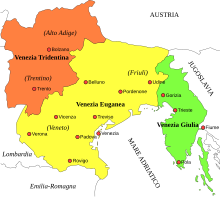 Triveneto (literally "Triple Veneto") is a historical region of Italy. The area is made up of the three smaller historical regions of Venezia Euganea ("Euganean Venetia"), Venezia Giulia ("Julian March") and Venezia Tridentina ("Tridentine Venetia").[3] This territory was named after the Roman region of Venetia et Histria. The entire area was under Austrian rule in 1863; Italy annexed Venezia Euganea in 1866,[4] following the Third Italian War of Independence and a controversial plebiscite (see Venetian nationalism); Julian Venetia and Venezia Tridentina passed under the Italian rule in 1919, following the end of World War I.[5] After World War II, Italy retained the most part of Tre Venezie, but lost Slovenian and Croatian majority areas of the upper Isonzo valley (together with the eastern part of Gorizia, today called Nova Gorica), the city of Fiume, most part of Carso region and most part of Istria to Yugoslavia.[6] The areas of Trieste (Zone A) and north-west Istria (Zone B) were formed in the Free Territory of Trieste: in 1954, Italy reannexed Zone A, while Zone B was ceded to Yugoslavia. Nowadays the name Triveneto includes the three administrative regions of Veneto, Friuli-Venezia Giulia and Trentino-Alto Adige/Südtirol 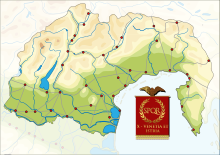 Venetia et Histria, an old region of Italy at the time of Roman Empire, refers to Veneto, Trentino, Friuli-Venezia Giulia, East Lombardy and Istria; it was named after the people of Veneti, who inhabited that region, and who are still largely the main ethnic group of the Italian area (other main ethnic groups include Friulani in the east, mostly in Udine province; Ladins in the Dolomites are between Veneto and Trentino-Alto Adige/Südtirol; Germans in South Tyrol; and Slovene minorities on the border with Slovenia and in the city of Trieste); while after 1947 Venetian/Istrian Italians are just a minority in Slovenian and Croatian Istria. Roman Venetia et Histria was originally created by Augustus as the tenth regio in 7 AD alongside the nine other regiones. The region had been one of the last regions of Italy to be incorporated into the Roman Empire.[7] It was later renamed by Diocletian the VIII provincia Venetia et Histria in the third century. Its capital was at Aquileia, and it stretched geographically from the Arsia River in the east in what is now Croatia to the Abdua in the current Italian region of Lombardy and from the Alps to the Adriatic Sea.[8] Venetia, a region which indicated the old land provinces of the Republic of Venice from river Adda to river Isonzo, and is sometimes still used today to indicate this territory together with Trentino and Trieste. GeographyIt borders to the north with Austria and Switzerland, to the east with Slovenia, to the south with Liguria, Tuscany, Marche and the small state of San Marino, to the west with Lombardy and for a very short stretch with Piedmont. Emilia-Romagna, Friuli-Venezia Giulia and Veneto are washed by the Adriatic Sea Northeastern Italy includes most of the Po Valley, crossed by the Po river, the longest river in Italy, and includes highly industrialized regions with a high tourist activity. DemographyIn 2022, the population resident in north-eastern Italy amounts to 11,532,690 inhabitants.[1] Regions
Most populous municipalities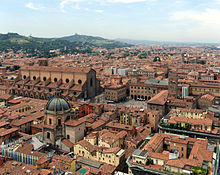 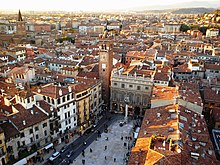  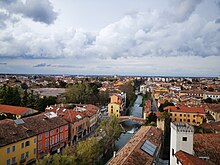 Below is the list of the population residing in 2022 in municipalities with more than 50,000 inhabitants.[1]
LanguagesItalian is the main language. Other languages include Venetian, widely spoken in Veneto and along the coast to Trieste and Istria, as well as in the towns of Pordenone and Gorizia in Friuli, and in most of Trentino, but only recognised by the Veneto region; Friulian, spoken in most of Friuli and nationally recognized, and Ladin, spoken by a few thousand people in the Dolomites. Other languages are German, the primary language of South Tyrol, where Italian is spoken by about two thirds of the inhabitants, and Slovene, recognized by Italy and spoken on the border of Italy and Istria, where the main language today is Croatian but Italian is recognized as a minority language due to the presence of the Istrian Italians. EconomyThe Gross domestic product (GDP) of the region was 407.9 billion euros in 2018, accounting for 23.1% of Italy's economic output. GDP per capita adjusted for purchasing power was 34,900 euros or 116% of the EU27 average in the same year.[9] See also
References
External links |
|||||||||||||||||||||||||||||||||||||||||||||||||||||||||||||||||||||||||||||||||||||||||||||||||||||||||||||||||||||||||||||||||||||||





